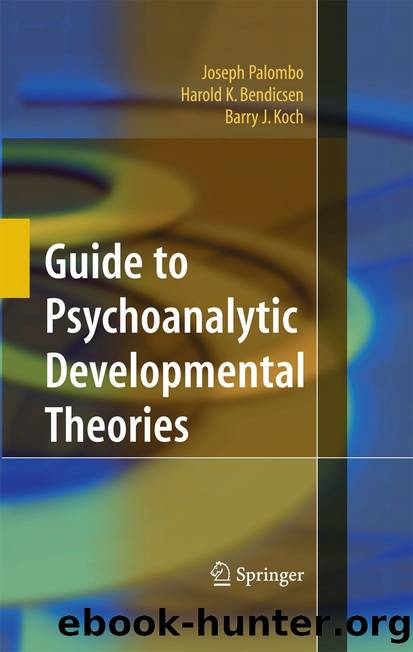Guide to Psychoanalytic Developmental Theories by Joseph Palombo & Harold K. Bendicsen & Barry J. Koch

Author:Joseph Palombo & Harold K. Bendicsen & Barry J. Koch [Palombo, Joseph]
Language: eng
Format: azw3
Publisher: Springer New York
Published: 2009-05-27T16:00:00+00:00
* * *
10.3 Theory of Development
In this organismic framework, Kernberg proposed that development occurs in five stages during which individuals metabolized the nutriments that relationships provide. The products of this metabolization process become gradually differentiated into internal structure, through Kernberg’s complex blending of Ego psychology, Jacobson and Kleinian concepts.
10.3.1 Normal Development
Stage 1. Normal Autism or Primary Undifferentiated Stage (Birth to 1 month):
The stage of Normal Autism or Primary Undifferentiated Stage, the earliest stage of development, precedes the consolidation of the “good” undifferentiated self-object constellation, which is built up under the pleasurable interactive experiences with the caregiver. Throughout this stage, the infants’ normal, primary, undifferentiated self–object representation is gradually constructed from the experiences associated with the interaction with the caregiver (Kernberg, 1976a, pp. 59–60).
Stage 2. Normal Symbiosis or Stage of the Primary Undifferentiated Self–Object Representations (1 month to 6–8 months):
During the stage of Normal Symbiosis or Primary Undifferentiated Self–Object Representation infants’ self- and object-images become differentiated within their emerging egos. In addition, infants consolidate “good” self- and object-representations in response to pleasurable, positive mother–infant interactions. Simultaneously, the infant organizes all negative experiences into “bad” self- and object-representations. These two separate object relations units constitute the first introjections, that is, the first psychological structures located in the infants’ immature ego. Object relations units is the term that Kernberg uses to refer to the building blocks of psychological structures. Each unit consists of three elements, a self, an object, and an affect dimension. These elements combine in sequence and become the building blocks for a super ordinate system of internal structures. Kernberg specifically disclaims that this framework is a neurophysiological or mechanistic model of the functioning of the psyche (Kernberg, 1976a, pp. 60–64).
Children invest the good self- and object-representations with libido, whereas they invest the bad self- and object-representation with aggression. Initially, these two kinds of object relations units are separate because of the physiological inability of the infants’ primitive ego structure to integrate them. Beginning at about the third to fourth month, the infants’ ego actively splits the two kinds of self- and object-images apart in order to protect the good self- and object-images from the destructiveness of the bad images. At this point, splitting becomes the primary defense of the developing ego. This stage encompasses Mahler’s symbiotic phase, in which self and object are not yet distinguished, and her differentiation subphase of the separation–individuation process. Kernberg collapsed the two phases into his developmental schema because he believed that in the differentiation subphase a fusion of self- and object-images could frequently reoccur.
Stage 3. Differentiation of Self- from Object-Representations (6–8 months to 18–36 months):
The stage of Differentiation of Self- from Object-Representations begins with the differentiation of self- and object-images, within the good and bad object relations units, and ends with the integration of both good and bad self-images and good and bad object images within the toddler’s ego. At the beginning of this phase, re-fusion of self- and object-images can still happen under stress, but during this phase ego boundaries are sufficiently well established that they are maintained even under stressful conditions.
Download
This site does not store any files on its server. We only index and link to content provided by other sites. Please contact the content providers to delete copyright contents if any and email us, we'll remove relevant links or contents immediately.
Cecilia; Or, Memoirs of an Heiress — Volume 1 by Fanny Burney(31333)
Cecilia; Or, Memoirs of an Heiress — Volume 3 by Fanny Burney(30934)
Cecilia; Or, Memoirs of an Heiress — Volume 2 by Fanny Burney(30889)
The Great Music City by Andrea Baker(21313)
We're Going to Need More Wine by Gabrielle Union(18074)
Bombshells: Glamour Girls of a Lifetime by Sullivan Steve(13109)
Pimp by Iceberg Slim(12931)
All the Missing Girls by Megan Miranda(12750)
Fifty Shades Freed by E L James(12451)
Norse Mythology by Gaiman Neil(11883)
Talking to Strangers by Malcolm Gladwell(11879)
Crazy Rich Asians by Kevin Kwan(8349)
Mindhunter: Inside the FBI's Elite Serial Crime Unit by John E. Douglas & Mark Olshaker(7834)
The Lost Art of Listening by Michael P. Nichols(6474)
Enlightenment Now: The Case for Reason, Science, Humanism, and Progress by Steven Pinker(6406)
Bad Blood by John Carreyrou(5769)
The Four Agreements by Don Miguel Ruiz(5511)
Weapons of Math Destruction by Cathy O'Neil(5037)
We Need to Talk by Celeste Headlee(4870)
